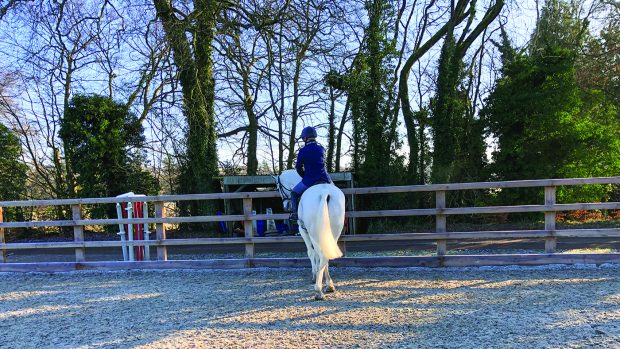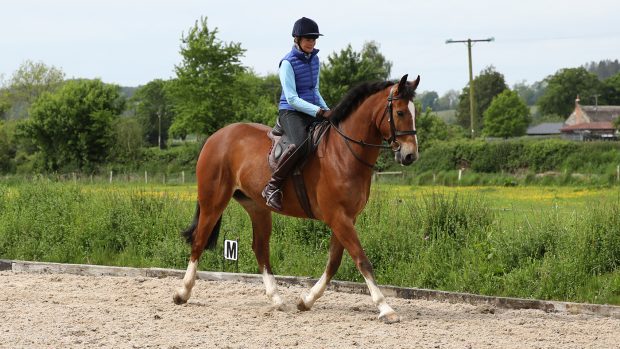In Ferdi Eilberg's demonstration at the British Dressage national convention last weekend (19-20 November), entitled 'International here we come — moving up to PSG and Inter I ', he worked with his son Michael's ride Sa Coeur and finished by giving some takeaway tips for all riders
Ferdi‘s final demonstration with his son Michael at the British Dressage national convention last weekend featured the double world young horse champion, Sa Coeur (pictured), now nine. The gelding has been successfully competing at small tour, and is the current intermediate I national champion.
“He’s an attractive, active horse but a little croup high and long in the loin,” assessed Ferdi. “But he’s beautifully produced, with all the tiny details addressed and very good flexion of the joints — particularly in the hindleg which helps make him naturally capable of sitting.”
He reported that the horse is “a bit of an introvert”, a quality which makes him very reliable in a competition atmosphere.
“We have to keep him quick and sharp behind to put his the hindlegs underneath him and get self-carriage,” he explained to the audience at Hartpury. “We don’t want him to get powerful in the sense of going forwards and with so much contact it becomes counter productive to the power of the hindleg.”
The horse would naturally like to be long and flat in his way of going.
“Whatever the horse finds easy from nature, we have to make sure we concentrate on the things the horse finds hard,” advised Ferdi. “This one likes to swoop forward in a big, flat way, so we work on keeping him sharp and active behind.”
Although the horse is confirmed at inter I level, Michael and Ferdi are careful to perpetually address the miniscule details that make all the difference in a test.
“We’re improving the collection still and keeping him interested in the work,” asserted Ferdi. “And we always aim to be competing at one level but exploring a level above that at home. Sa Coeur knows the moves so we work on the basics and making tiny changes and improvements.
Creating interest
Michael brings Sa Coeur back to walk, then begins to test out the half-steps — a sort of baby, early-stage version of the piaffe.
“Playing with the half steps works both sides of the coin,” explained Ferdi.
“It creates interest in something new and also improves and perfects the ability to build the hind quarters in strength so the horse can carry himself even better in the movements he actually has to perform in competition now. The business of learning involves pushing the boundaries.”
Michael rode unusual lines around the arena for much of the session.
“We’re always reminding Sa Coeur not to go into the big swoop, but to stay quick so Michael immediately stops him from swooping off into a big step and brings him back when that happens. It’s also good to ride interesting lines with a horse that wants to be big and onward bound as they have less chance of guessing where they’re going. His comfort place is long and out, so we keep reminding him that if he has the hindleg under then he can hold himself up.
To take this theory one step further, Michael moves up into canter and, once happy with the quality of the pace, rides some working pirouettes.
“Feel what the horse is doing in the canter,” he advised. “In the pirouette if they want to turn too fast then change your mind and only ride half a pirouette to show you’re not prepared to accept that and finish the movement regardless. The rider must direct the balance of the strides. The more energy Sa Coeur puts in, the easier it is for him to perform the movements. It’s all about him learning the balance.”
“Don’t stress about the size of the pirouettes — we are improving the canter and, when that happens, the smaller size will be available to you naturally.”
Like this? You might also enjoy reading these:
Ferdi and Michael Eilberg: 7 training tips sure to improve your horse’s performance
Ferdi Eilberg: don’t be too greedy with a talented horse
6 takeaway tips from Ferdi Eilberg
1. Whatever you do on one rein, make sure you repeat on the other.
2. Theoretically the poll should be the highest point in competition, but you can make concessions dependant on conformation – e.g. a stallion with a big cresty neck.
3. If the horse is working properly behind and lowering the quarters as desired, then the neck position is almost secondary as the main balance comes from the hindlegs going down and the shoulders going up.
4. Plaits can change the impression of the shape of the neck, so think carefully about how to plait your horse.
5. If you decide to ride to the other end of the arena, then use the time well, perhaps with a leg-yeild or some flying changes.
6. Assess what the horse gives you from nature then make it your job to to constantly look after the other side so you can draw on both well enough in tests.




